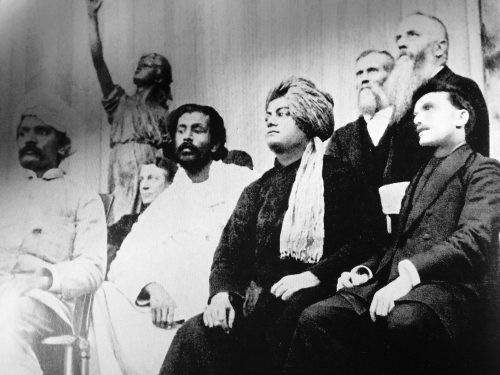Sunday Sep 13, 2020 NYC

Editor’s Note: Pranavadipa Volume 70
“Even if the world is chaotic, it’s not the world that is struggling.
What is struggling, what is suffering, is each and every individual mind.
Therefore, what needs to be healed is each and every person.”
—Shri Mahayogi, January, 2013 in Kyoto
It is said that the Truth is one and the same, throughout all eras—past, present and future—across all locations, and in all people, regardless of creed, culture, or any other factor.
The world may seem to be increasingly turbulent, uncertain and filling with hardship, yet the same teaching of Truth that has been taught from thousands of years ago, should apply to modern times, regardless of the ebb and flow of seeming stability or instability within the circumstances of the world.
At times in our lives we may look around us and perceive joyfulness and prosperity within our world, while at other times we may experience quite the opposite, and instead perceive pain and suffering. Then of course, there is every experience in between, various combinations of these two extremes.
How can we manage amidst the uncertainty of the worlds ups and downs, not to mention the ups and downs of our own minds? How can we live upon Yoga to ease the suffering of our own minds, of the people around us, and of the entire world?

Swami Vivekananda on the platform of the World’s Parliament of Religion, Chicago Sept 1893. He was at 30.
The year 2013 was the 150th anniversary of Swami Vivekananda’s holy birth. Swami Vivekananda is one of a few Enlightened Beings that Shri Mahayogi advices his disciples and seekers to study and learn from, so naturally disciples had already determined to focus the entire year around aligning themselves especially with the teachings and life of Vivekananda, to bring his spirit concretely into the 21st century. What an inspirational undertaking in and of itself—to bring and embolden the spirit of a great saint into the modern day will undoubtedly bring the reach of the positivity of Truth to an ever-widening circle! The content of this month’s Pranavadipa (Vol. 70) is from a few Satsangha held in Kyoto, Japan during that year, 2013, one of which is from a Satsangha that took place at the Ashrama, which happened to be on the exact day of the birth of Swami Vivekananda, and from the Satsangha that took place on the Saturday that followed. Thus, many of the topics in this Satsangha naturally center around what attendees have been learning about Vivekananda as they strive to understand his spirit and dynamic work, and to align themselves with him.
The details of the world’s happenings of course differ from what they are today, yet there is much to learn from the life and teachings of Vivekananda for those of us living in today’s world of 2020, too, and much that we can apply, especially with Shri Mahayogi as our guide, constantly illuminating and clarifying the truth of Yoga for us in a way that we can better understand and move forward boldly. The contents, in fact, come to us this month at what seems to be just the right moment.
*
“A single individual’s experiences are truly insignificant.
However, meditation contains the power
that can expand one’s experience to a cosmic scale.”
—Shri Mahayogi January, 2013 in Kyoto
It may be a common human experience to live our lives day-to-day and be caught up in the matters that most concern us—our interactions, our activities, our own experience. Our own little world may expand to a variety of reaches, but no matter the reach, it is most likely revolving around each one of ourselves—in other words, the “I” is always at the center and everything that is seen and understood is through the experience of this “I”.
In the content of the Satsangha this month, through the example of Swami Vivekananda, Shri Mahayogi is pushing us to expand beyond the world of our own experience, to break through the limitations of our mind and its many notions and ideas that stand in the way of us being able to sense the need of the world—beyond just our own scope—and act accordingly. Shri Mahayogi also breaks down the reality of the world and its nature, the reason for which Swami Vivekananda spoke of “a peaceful world” as “hot ice,” and goes on to teach us about the necessity and power of ekagrata, the cultivation of faith, the way of learning through aiming towards an ideal being, and the importance of working in the world for the healing of suffering.
Also, in one part of the Satsangha there is a question posed to Shri Mahayogi by Yukti, the disciple of Shri Mahayogi whose articles “Living on the Words of Mother” were published over the last three Volumes of Pranavadipa (Vol. 67-69) as the Testimony. At the time of one of the Satsangha contained here in this Volume, she was about to move to Fukushima to work as a nurse, to live on the words of Mother Teresa. It is very inspiring to read her question and answer from Shri Mahayogi. Because, in addition to the Testimony that we read from her, this is a great insight into Yukti’s thoughts at that time, and her sincerity, of course. Even though aiming towards her ideal of Mother Teresa, her base was in Yoga and she was constantly guided by her Guru, Shri Mahayogi. Yukti said that her departure to Fukushima was approaching, and reflecting on what she had learned in the past 15 years in Kyoto under Shri Mahayogi, she asked a question related to an answer she received from him that struck her about the state higher than Nirvana, which is Lila, and asked him to explain further. That question led her and us to receive some phenomenal answers from Shri Mahayogi’s exceptional understanding of the meaning of the Yoga Sutra, and the spirit and words of Ramakrishna, Swami Vivekananda and Buddha!
There is so much to learn from these Satsangha, how Shri Mahayogi teaches us about Vivekananda, Vivekananda’s example itself, and the hunger and sincerity of the disciples striving to bring betterment to the world around them through Yoga. We hope that readers will also feel uplifted and inspired into action, to work towards bringing betterment to our present-day circumstances.
*
This month’s Testimonies by Gopala and Ms. Mitsui, both reveal in different ways, how these disciples of Shri Mahayogi wholeheartedly work on the assignment that Shri Mahayogi gave for the third year of the Siddha Marga (Path to the Completed One) program (2013-2015) led by two senior disciples in Kyoto, Japan. The assignment for those attending the program was to choose an “ideal saint” to meditate on—trying to come closer through meditation, through trying to understand and follow the example of one’s ideal saint as a concrete way to deepen oneself toward Yoga. These articles were written this year, so we can catch a sense of the continuous effects that come as a result of continuous and consistent practice, even after some years later.
The first Testimony is written by Gopala, who lives in Kyoto, Japan. His article illustrates precisely how he is using his chosen ideal, Swami Vivekananda, in his journey over the years as he strives to practice, simply and concretely, to bring himself closer to understanding Vivekananda, and thus Shri Mahayogi and the teachings of Yoga. In fact, the exact words of Shri Mahayogi, spoken during the Satsangha in 2013, which is included in the content of this Volume of Pranavadipa, appear in Gopala’s Testimony, as words that have been consistently guiding him in his practice. And furthermore, we can also see the guidance that he was given by Yukti in conversations before she moved to Fukushima, which triggered him to realize something very important about where and how to focus his practice. This interaction also reveals the insight of Yukti, as well as one of the important functions of sangha—support and inspiration.
One of the great qualities that we can see in the journey of Gopala is the consistency he keeps in continuing to strive to come closer to his ideal and to continue to practice the simple things that are right in front of him. Through doing so, little by little, his understanding of the words and life of Vivekananda, his understanding of the teaching of Yoga, and his understanding of his Guru, Shri Mahayogi, grows and transforms…all through taking simple actions. As the Yoga Sutra explains:
“That practice however becomes firmly grounded
when it is continued accurately for a long time.” (Yoga Sutra 1.14)
There may be times when we might catch the belief that “practicing Yoga” means something much more grandiose than what it actually is, which as a result can make it seem a bit impossible to perfect, or in some cases, even begin. But the example of Gopala verifies and lets us see clearly that taking small actions, consistently over time, certainly leads to progress, transformation of oneself, and deepening in Yoga. Why not practice that way too?
The second Testimony is from Ms. Mitsui, who lives in the north part of Japan, far away from Kyoto (1005 km/625 miles), and it seems she is only able to travel the distance to come see Shri Mahayogi once a year at most. The rest of the time, she practices completely on her own, propelled by her own striving to come closer to the true Self, closer to God. Her example is a great gift for many of us who might not have many opportunities to see the Guru, or a great master. In her writing in this Testimony, we can see that Ms. Mitsui, by hearing about Shri Mahayogi’s assignment to the participants of Siddha Marga in Kyoto, even though she was not a part of this program, due to living far away, she did not take this assignment to the participants as just for them, but took this as an instruction that she herself should also strive towards. What an inspiring example of proactiveness—when we are hungry to find something, we are ready and willing to take up any clues that come along the way!
In this Testimony, she begins by writing about a novel of a well-known Japanese author, Shusaku Endo, called Silence (the translation to English is available as well as a movie, directed by Martin Scorsese), the theme of which is around faith—quite a universal subject; and this novel prompted her to ask herself whether or not she could uphold faith. Her writing reveals some of her own journey, touches upon prayer, meditation, God, the words of Paramahansa Yogananda; we can also see how the world of Yoga has opened up for her, and how her precious interactions with Shri Mahayogi have brought her incomparable guidance for how and what to aim her life towards—Satori, Awakening.
Yoga is practicable for everyone, regardless of background or circumstances. In both Testimonies, we can see how simple and practical the practice of Yoga can be. Sometimes the simple things can be overlooked or sometimes the simple things are more difficult for us to practice. But we should remember that simple things are but simple things—when practiced continuously, with sincerity and consistency, these simple actions centered in Yoga most assuredly can lead to bringing positive and sweet-scented transformation to ourselves and those around us.
